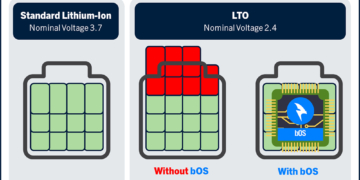 Cell (2022). DOI: 10.1016/j.cell.2022.03.023″ width=”800″ height=”530″/>
Cell (2022). DOI: 10.1016/j.cell.2022.03.023″ width=”800″ height=”530″/> Graphical abstract. Credit: Cell (2022). DOI: 10.1016/j.cell.2022.03.023
Therapies based on engineered immune cells have recently emerged as a promising approach in the treatment of cancer. Compared to traditional drugs, engineered immune cells are more precise and sophisticated in their ability to detect and eliminate cancer cells.
But despite their promise, cell-based therapies still face important limitations, including toxicity and the possibility that they could attack healthy cells. In addition, scientists don’t have a good handle on how to modify existing therapeutic cells to expand their applications or better control their activity.
To overcome these limitations, researchers at Gladstone Institutes and UC San Francisco (UCSF) undertook a systematic analysis of the molecular building blocks used to engineer therapeutic cells. Their work, reported in the journal Cellresulted in a comprehensive rule book for the design of therapeutic cells with improved specificity and safety, and for the eventual customization of cell-based therapies.
“We have identified principles that should greatly facilitate the engineering of therapeutic cells with greater sensitivity, accuracy, and safety than was possible before,” says Kole Roybal, Ph.D., an associate professor in the Department of Microbiology and Immunology at UCSF, an affiliate investigator at Gladstone Institutes and core member of the Gladstone-UCSF Institute of Genomic Immunology, a Parker Institute for Cancer Immunotherapy investigator, and the study’s senior author. “Our work will provide biomedical researchers with a toolkit for directing a range of cell-based therapies to their intended targets and for programming their therapeutic activities.”
Building a better receptor
At the core of most therapeutic cells is a molecule called a receptor. Receptors are large proteins that straddle the cell’s outer membrane. Their outer portion recognizes a specific target (for instance a protein on the surface of a cancer cell) and their inner portion tells the cell what to do upon recognizing this target. One way to engineer a therapeutic cell is to insert in a cell—often an immune cell called a T cell—a synthetic receptor made by piecing together fragments of known receptors.
This approach was used to create CAR-T cells, which have proven very effective at eliminating some types of blood cancers. CAR-T cells harbor a “chimeric antigen receptor” (CAR) that is based on a receptor normally found in T cells.
Starting with a different backbone, Roybal previously developed a receptor called synNotch that can direct T cells to better recognize and kill solid tumors. Since this early stage research, Roybal’s lab has shown how synNotch can be used in combination with CARs to develop next-generation cell therapies for ovarian cancer and mesothelioma. The synNotch receptor allows scientists to precisely control when and where the therapeutic T cell is active.
“These smart cell therapies can unleash potent therapeutic activity precisely at the site of disease, improving the efficacy of the therapy and reducing the chance of life-threatening toxicities seen in patients,” says Roybal.
However, the original synNotch receptor is difficult to deploy for cell-based therapy in humans. For one thing it is bulky, which makes it difficult to insert into human cells. For another, some of its parts come from mouse, yeast, and viruses instead of human receptors, which could lead to immune rejection of the engineered cells once introduced in a patient.
To understand what they could keep and remove from the synNotch receptor without losing its desirable features, the Roybal team systematically swapped out various portions of the receptor. After inserting the modified receptors in human T cells, the scientists tested their ability to recognize their intended targets and activate the expected response.
“A challenging but fun feat was figuring out how different parts of known receptors function, so that we could take those pieces apart and put them back together in novel ways to meet our design specifications,” says Raymond Liu, Ph.D., a first author of the study and postdoctoral fellow in Roybal’s lab.
In the end, the team produced a catalog of receptors they dubbed SNIPRs, which are small enough for cost-effective engineering into human cells. They are also made exclusively from human receptor fragments and can detect and respond to even small amounts of their targets. In addition, the activity of SNIPRs can be adapted so that cells that harbor them don’t just kill target cells, but can also deliver specific molecules to precise disease locations.
“Understanding the rules of receptor design allowed us to build receptors that are more effective and also better suited for clinical translation,” says Iowis Zhu, a graduate student in the Roybal Lab and the other first author of the new study.
A platform for next-generation cell therapy
The researchers next assessed the ability of these optimized receptors to clear tumors in mouse models of leukemia, mesothelioma, and ovarian cancer.
To reduce the chances of killing non-target cells, they combined a SNIPR designed to recognize one molecule on the tumor with a CAR receptor tuned to another tumor molecule. Moreover, they made the production of the CAR receptor dependent on the activation of the SNIPR receptor. This way, only cells carrying the targets of both the synNotch and the CAR receptors would be killed, while cells carrying only one target would not.
In each of the three cancer types they tested, this two-step targeting strategy led to more selective elimination of cancer cells than could be achieved with either receptor alone, highlighting the promise of this approach to reduce off-target toxicity of cell therapies.
Cell therapies based on SNIPRs are now being optimized for the treatment of ovarian cancer, renal cancer, prostate cancer, and glioblastoma in both the academic setting and a company called Arsenal Bio, co-founded by Roybal.
And cancer may not be the only condition that could be treated with SNIPR-based cell therapy.
This receptor system is also amenable to enhancing the anti-inflammatory activity of immune cells for the treatment of autoimmunity. In addition, SNIPRs could be used to target stem cells or other cell types to detect tissue damage and induce tissue repair or the reversal of fibrosis.
“Engineered cells have the potential to operate as much smarter therapeutics than traditional small molecules and biologics,” says Roybal. “We’re hoping our new receptor system will serve as a technology platform enabling scientists and clinicians to design safer, targeted, and more effective cell-based therapies against cancer and many other diseases.”
CAR-T therapy modifications provide new promise for cancer immunotherapies
Iowis Zhu et al, Modular design of synthetic receptors for programmed gene regulation in cell therapies, Cell (2022). DOI: 10.1016/j.cell.2022.03.023
Cell
Provided by
Gladstone Institutes
Citation:
A new toolkit to engineer safe and efficient therapeutic cells (2022, April 15)
retrieved 17 April 2022
from https://medicalxpress.com/news/2022-04-toolkit-safe-efficient-therapeutic-cells.html
This document is subject to copyright. Apart from any fair dealing for the purpose of private study or research, no
part may be reproduced without the written permission. The content is provided for information purposes only.














